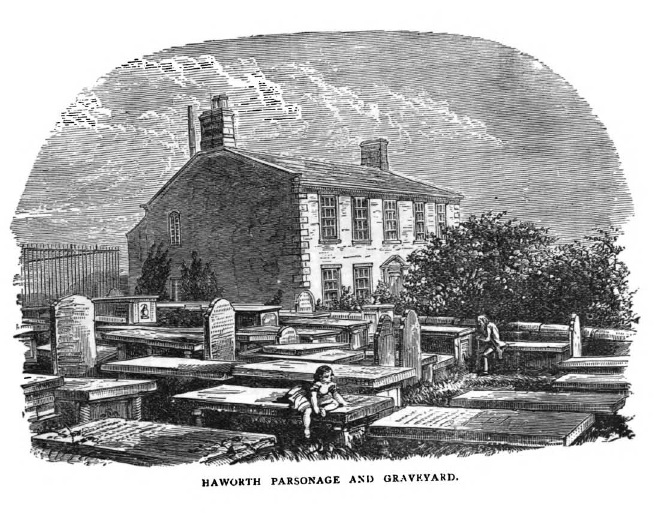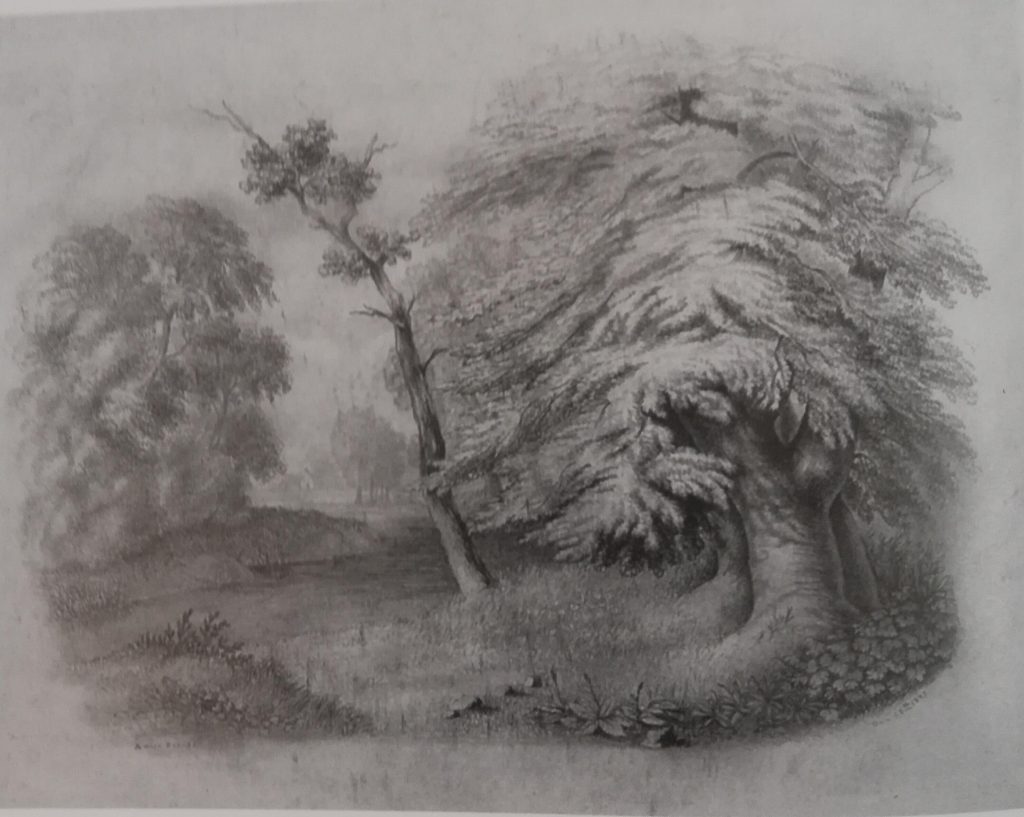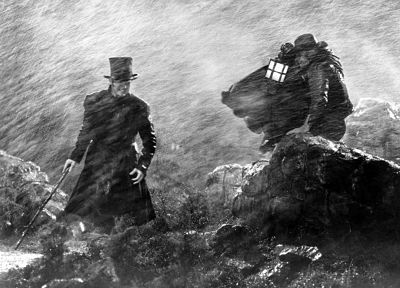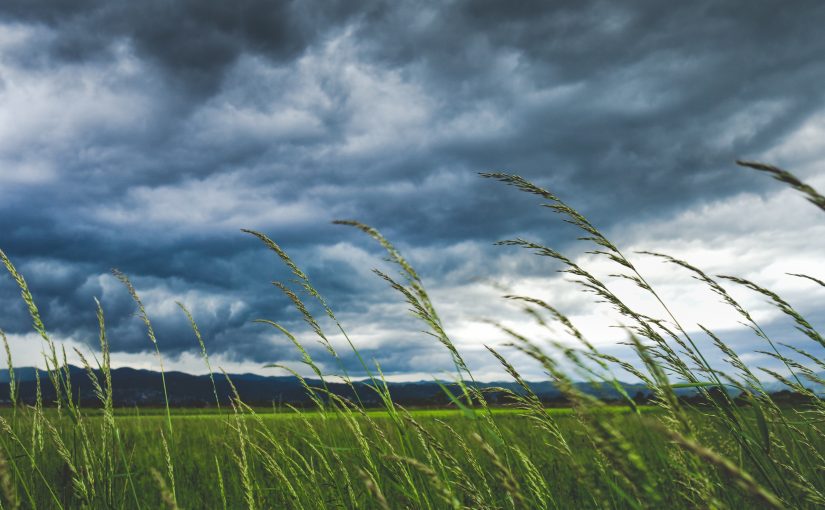Storm Ciara is battering the United Kingdom and Ireland this weekend, so it seems a perfect time to look at storms and wind in the Brontë’s writing and lives. As visitors on Brontë pilgrimages soon find out, Haworth is in an elevated position, surrounded on three sides by moorland. Situated at the top of the steep Main Street, the Brontë Parsonage itself is particularly exposed, so it can often be subjected to severe winds and heavy rain.

For visitors today this only adds to its beauty and atmosphere, but for its Brontë inhabitants it could also bring problems, as Charlotte Brontë made clear in a letter to Ellen Nussey in December 1846: ‘the wind is as keen as a two-edged blade. We have all had severe colds and coughs in consequence of the weather. Poor Anne has suffered greatly from asthma, but is now, we are glad to say, rather better. She had two nights last week when her cough and difficulty of breathing were painful indeed to hear and witness, and must have been most distressing to suffer; she bore it, as she bears all affliction, without one complaint, only sighing now and then when nearly worn out. She has an extraordinary heroism of endurance. I admire, but I certainly could not imitate her.’
Nevertheless, Anne and Emily Brontë especially loved the wild, windy weather. Perhaps this is even more remarkable when we consider that we wouldn’t head out today without thick, waterproof coats on and sturdy boots, but nothing of the sort would have been available to the Brontës. Stormy weather wouldn’t stop Emily and Anne from taking a walk across the moors, the solution for them was to put on an extra layer or wrap another shawl tightly around themselves.
Their love of stormy weather can be seen plainly in their work. One of Anne’s earliest extant poems is even called ‘The North Wind’ and in it, under the disguise of a Gondal setting, she reveals how much she adores hearing the wild wind:
‘That wind is from the North, I know it well;
No other breeze could have so wild a swell.
Now deep and loud it thunders round my cell,
The faintly dies,
And softly sighs,
And moans and murmurs mournfully.
I know its language; thus is speaks to me —
‘I have passed over thy own mountains dear,
Thy northern mountains – and they still are free,
Still lonely, wild, majestic, bleak and drear,
And stern and lovely, as they used to be
When thou, a young enthusiast,
As wild and free as they,
O’er rocks and glens and snowy heights
Didst often love to stray.’

Emily was also inclined to praise stormy weather in her poetry, on more than one occasion. It often personifies a longing for, or love of, home as in this extract from Emily’s brilliant ‘F. De Samara To A.G.A.’ – more commonly known by its opening words, ‘light up thy halls!’:
‘How gloomy grows the Night! ‘Tis Gondal’s wind that blows,
I shall not tread again the deep glens where it rose –
I feel it on my face – Where, wild blast, dost thou roam?
What do we, wanderer, here, so far away from home?
I do not need thy breath to cool my death-cold brow,
But go to that far land, where she is shining now;’
Of course, the most well known reference to stormy winds in all the Brontë canon can be found in the title of Emily’s only novel Wuthering Heights – wuthering being a Yorkshire dialect word for a cold, howling wind of the kind that would be familiar to those living out on the moors like the Earnshaws and the Lintons (or the Brontës). Wild weather is almost a character in this novel, with the word ‘wind’ occurring 29 times and ‘storm’ featuring on a dozen occasions.

I will leave you with Anne’s brilliantly evocative poem, ‘Lines Composed In A Wood On A Windy Day’. This poem expresses Anne’s joy at wild weather, whether it be at Haworth, Thorp Green (where she composed this poem in 1842) or at her beloved Scarborough, watching waves crash against rocks. Even so, I don’t think Anne would have been wise to take a walk in conditions such as those that Ciara is bringing us – my advice to you all is take care, keep indoors, and settle down with a good book and a cup of something warm (whether that be tea, coffee, cocoa or whiskey I leave down to you). Let the storm do its worst!
‘My soul is awakened, my spirit is soaring
And carried aloft on the wings of the breeze;
For above and around me the wild wind is roaring,
Arousing to rapture the earth and the seas.
The long withered grass in the sunshine is glancing,
The bare trees are tossing their branches on high;
The dead leaves, beneath them, are merrily dancing,
The white clouds are scudding across the blue sky.
I wish I could see how the ocean is lashing
The foam of its billows to whirlwinds of spray;
I wish I could see how its proud waves are dashing,
And hear the wild roar of their thunder today!’

Wind and storms are wonderful, and all too rare here in Southern California. We have a light storm today, and I am enjoying Anne’s poem.
I finished Crave the Rose and loved it! The dialogue between C and S was so fascinating and timely in my own life. In the last section, there are more than a few references to photographs. Inclines me to believe even more that the daguerreotype is real.
Thank you so much Eric – although I envy your Californian weather! I’m so glad that you enjoyed my book! Yes, I believe that the daguerreotype is real too.